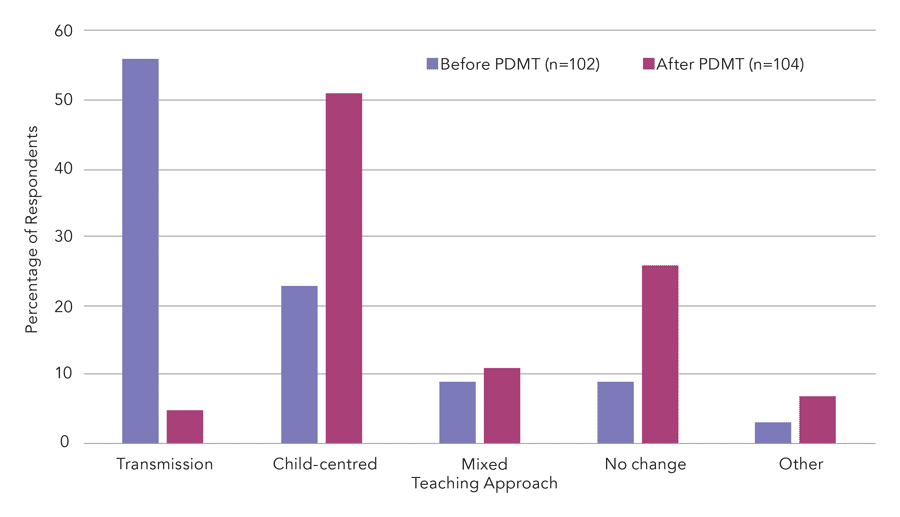A blended learning programme for out-of-field mathematics teaching
School principals, confronted by a scarcity of qualified post-primary mathematics teachers, have a tendency to assign mathematics lessons to teachers qualified to teach subjects other than mathematics. This practice, known as ‘out-of-field teaching’ is an international phenomenon with particular prevalence in the teaching of mathematics.
Out-of-field mathematics teachers in secondary schools tend to lack both the knowledge of how to teach mathematics successfully and the depth of mathematical knowledge to ensure students understand the subject. Furthermore, these teachers are inclined to feel their sense of professional competence undermined with lack of confidence, stress and feelings of inadequacy.
The research team at EPI*STEM, Ireland’s National Centre for STEM Education based at the University of Limerick, conjectured that out-of-field mathematics teaching may well be contributing to the under-performance of Irish secondary school students in mathematics. They also thought it could be obstructing the successful implementation of the new mathematics curriculum. In 2009, their national survey of mathematics teachers in Irish secondary schools revealed that 48% of the survey’s participants were actually teaching mathematics out-of-field.

Professor Merrilyn Goos, Professor of STEM Education at the University of Limerick, and Director of EPI*STEM – the National Centre for STEM Education describes the design of a national blended learning programme – the Professional Diploma in Mathematics for Teaching (PDMT), developed in response to this finding. Funded by the Department of Education and Skills, PDMT provides out-of-field teachers of mathematics with the knowledge and skills to teach mathematics proficiently.
A national priority
Raising standards in mathematics is a national priority. The Irish government committed approximately €7 million to funding the mathematics teacher professional development programme from 2012-2020. PDMT, designed by the research team at EPI*STEM, is delivered through a national network of 14 higher education institutions. So far, 1068 teachers have graduated from the programme, described by the national media as a “historic step in terms of supporting maths teaching in post-primary schools”.
Our model highlights the distinctive professional development needs of out-of-field teachers and the characteristics of professional development programmes that meet these needs.
In 2018, a repeat of the 2009 survey showed a significant decline in the out-of-field teaching of mathematics to only 25% of respondents. Moreover, researchers at EPI*STEM have observed the positive effects of the PDMT of the former out-of-field teachers’ teaching practices and beliefs after completing the programme.
Mathematics teacher professional development
The PDMT offers professional development for out-of-field teachers of mathematics in line with the new mathematics curriculum and the requirements of the Irish Teaching Council. Post-primary teachers graduating from the two-year part-time programme are deemed to have met the Teaching Council’s requirements for Mathematics teaching in post-primary schools.
Programme structure
The PDMT is a blended professional learning programme. Blended learning, combining both face-to-face and online delivery, is popular in higher education. Participants combine their studies with teaching full-time in schools. The PDMT comprises ten mathematics content modules, delivered online with additional face-to-face and online support, and two mathematics pedagogical modules, delivered face-to-face. The mathematics content modules are presented in six-week sessions, with four lectures and a tutorial each week, covering calculus, algebra, probability, statistics, geometry, problem solving and modelling, and history of mathematics.
The mathematics pedagogy modules concentrate on developing pedagogical content knowledge. They are linked to corresponding mathematics content modules so that pedagogical content knowledge and subject content knowledge can be developed in parallel. The latter includes participants completing an action research project on their classroom practice and their compulsory attendance of five three hour workshops together with a weeklong summer school. A wide range of assessment is employed throughout the programme. This includes written assignments, participation in workshops, mathematics problem sets, supervised examinations and projects.

Boundary crossing
Professor Goos explains how the implementation of the PDMT programme is underpinned by ‘boundary crossing’. Initially, boundary crossing described how professionals in work situations were able to function in fields where they were fundamentally unqualified. This concept has grown to include boundaries between communities, practices, disciplines, and activity systems. This makes boundary crossing a suitable vehicle for the study of a multifarious professional development programme such as PDMT.
Design features of the PDMT
The research question forming the cornerstone of this study is: How does a blended learning environment contribute to effective professional learning for out-of-field teachers of mathematics? In order to answer this, the research team devised a new theoretical model to rationalise the design features of the PDMT programme. They apply the notion of boundary crossing to analyse the design features of the PDMT using three theoretical frameworks to explore the particular combination of factors within this blended learning environment and position this research within the existing literature in this discipline.
Three theoretical frameworks
The research draws on three perspectives or theoretical frameworks to inform the analysis of the blended learning design. Firstly, the blended learning perspective that crosses the boundary between face-to-face and computer-mediated teaching and learning. Secondly, the perspective of the out-of-field teacher crossing discipline boundaries between the subject they are qualified to teach and mathematics. Thirdly, from the perspective of the mathematics educators and mathematicians who design and teach the PDMT programme.
Blended learning framework
The researchers identified the four critical dimensions of blended learning environments: space, time, fidelity, and humanness, as a boundary object facilitating the harmonisation of face-to-face and computer-mediated instruction.
The PDMT is an exemplar model for the professional development of out- of-field mathematics teachers deploying blended learning.
The space dimension combines separate physical and virtual spaces. The physical spaces include face-to-face tutorials, workshops, summer school and the classrooms where the participants teach and conduct their action research. The virtual spaces are made up of the lectures streamed on specific evenings and posted to the course website for repeated viewing and the online tools facilitating interaction between tutors and participants.
The time and fidelity dimensions allow real-time and delayed interaction with a high level of fidelity including interactive video and web-based resources, online software and applets as well as text-based materials.
The humanness aspect has evolved over time. Originally, human interaction was present throughout the programme; for example, mathematics lectures were broadcast from the primary site and mediated by local mathematics lecturers at secondary sites who also provided face-to-face interactions and tutorials. The ratio of face-to-face to online interaction is now approximately 1:2 due to the development of a suite of video-recorded lectures and technological improvements facilitating online tutorials. Professor Goos emphasises that fully human interaction is central to the mathematics pedagogy sections of the programme, which have always been offered face-to-face.

Out-of-field teacher framework
The research revealed that contextual factors, support mechanisms and personal resources influence the out-of-field teachers’ engagement and level of success with the PDMT.
Contextual factors, including the considerable commitment in terms of the time and travel required over the two year programme, as well as the substantial mathematics content, dictated by official policy, led to issues, such as lack of perseverance or willingness to engage, for some participants. For many of the participating teachers, these issues were intensified as their need to secure ongoing employment in their schools undermined the voluntary nature of participation. These issues were largely addressed with flexibility in the programme design and the addition of online learner supports including online tutorials, screen casts, and lecture notes.
Support mechanisms were implemented as the PDMT evolved. School support, such as mentoring and release time, are usually not available for teachers participating in professional development programmes in Ireland. Programme supports include study support, such as face-to-face and online tutorials and online resources, social contacts including moderated chat room and personal bookable online tutorials, and online programme information and navigation aids, such as a student handbook, programme calendar and module booklets, have been made available to participants.
Participants’ personal resources, such as their confidence, commitment and adaptive expertise and the development of their mathematics content knowledge and pedagogical content knowledge, were a significant contributor to their growing self-efficacy as well as to programme design.
Teacher professional development framework
The professional development framework identifies the structural and core features relating to the PDMT design that are required for effective teacher professional development. The structural features focus on the form, i.e. the criteria for the successful completion of a university validated graduate programme, together with the duration and coherence of activities and the nature of the teachers’ participation. The core features focus on the mathematical content knowledge and opportunities afforded to participants to engage in active learning.
Broader impact
Professor Goos remarks that “our model highlights the distinctive professional development needs of out-of-field teachers and the characteristics of professional development programmes that meet these needs”. Employing the three boundary crossing frameworks exposes the signature features of the PDMT blended learning design, and reveals how they enable the PDMT to improve teachers’ mathematical knowledge on a national scale in Ireland. The PDMT is an exemplar model for the professional development of out-of-field mathematics teachers deploying blended learning that could be adopted by other nations to upskill their teachers.
Personal Response
How will standards in post-primary mathematics be maintained, or possibly raised further, after the funding runs out in 2020?
<> EPI*STEM remains committed to reducing the incidence of out-of-field teaching of post-primary mathematics. In late 2019 the Higher Education Authority of Ireland announced the award of €350,000 to EPI*STEM, based on the research impact case study of the PDMT submitted by the University of Limerick. (See https://hea.ie/funding-governance-performance/managing-performance/institutional-stories-of-impact/university-of-limerick/). This funding will allow us to adapt existing PDMT materials to produce a high quality online CPD programme focusing on mathematical knowledge for teaching. We will evaluate the programme’s impact via a national survey of teacher knowledge, confidence, classroom practices, and perception of student learning and engagement following teachers’ participation in the CPD.